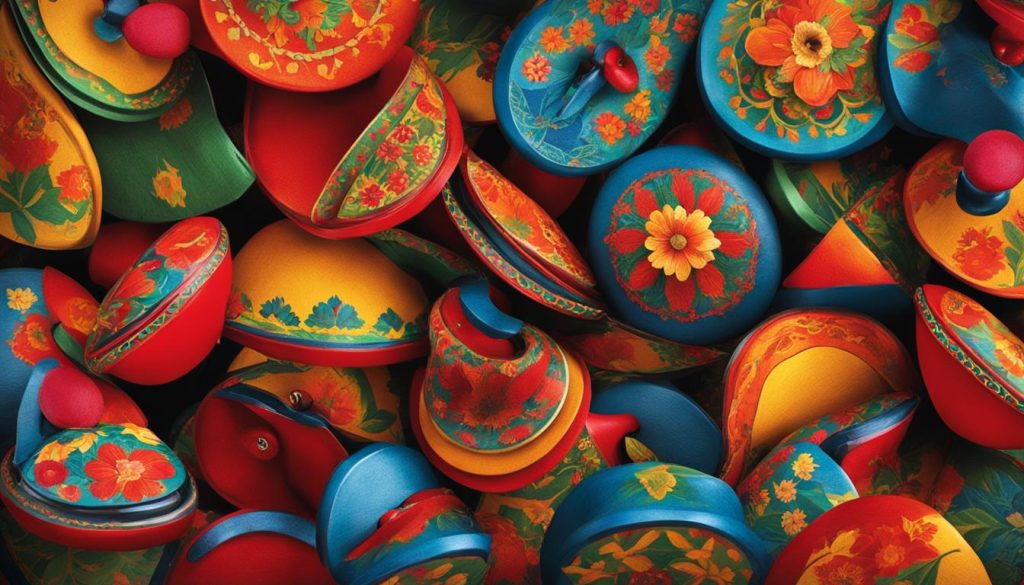If you’ve ever wondered about the origins of castanets, their cultural significance, and the differences between Spanish and Mexican versions, you’ve come to the right place.
In this article, we’ll explore the fascinating world of castanets, the percussion instrument that finds its home in various music traditions, including both Spanish and Mexican.
So, are castanets Spanish or Mexican? Let’s delve into the details to find out.
Content
The Cultural Significance of Castanets

Castanets have played an important role in the cultural traditions of Spain and other regions for centuries. In Spain, they are used in various folk dances, such as the Jota and Fandango, as well as in flamenco performances.
They add rhythm and accentuate the movements of the dancers, creating a vibrant and lively atmosphere.
Castanets are also featured in classical music compositions, particularly during the Baroque period, where they were used in dances representing different cultures and characters.
The distinct sound of castanets is often associated with the rich cultural heritage of Spain, making them a symbol of Spanish folk music and dance.
The rhythmic patterns produced by the castanets enhance the overall experience of traditional Spanish dances.
The dancers skillfully control the castanets, using them to punctuate the music, emphasize specific beats, and synchronize their movements. This intricate interplay between the dancers and the instrument is what makes castanets an integral part of the Spanish folk music tradition.
The Role in Classical Music
Castanets are not limited to folk and flamenco genres; they have also found their place in classical music compositions.
During the Baroque period, composers utilized castanets in orchestral works and ballets to depict various cultures and characters.
The distinctive sound of castanets added an authentic touch to these compositions, enhancing the overall atmosphere and providing a unique auditory experience for the audience.
Symbol of Spanish Culture
Due to their historical significance and association with Spanish cultural traditions, castanets have become a symbol of Spanish folklore.
They represent the passion, energy, and rhythmic essence of Spanish music and dance. The unique sound of castanets instantly transports listeners to the vibrant streets of Spain, immersing them in the country’s rich cultural heritage.
The use of castanets in Spanish folk music and dance showcases the deep-rooted traditions and artistic expressions that have been passed down through generations.
The instrument’s presence in both traditional and contemporary settings highlights its enduring cultural significance.
| Castanets Facts | |
|---|---|
| Origin | The exact origins of castanets are uncertain, but they are believed to have ancient roots dating back to at least the Roman era in Hispania (Spain). |
| Materials | Traditional castanets are made from hardwood, such as chestnut, to produce the desired sound. However, variations may use other materials, such as metal or synthetic materials. |
| Playing Technique | Castanets are played by holding a pair in each hand and striking them together or against the palm to create the distinctive clicking sound. Skilled castanet players can produce complex rhythms and melodies. |
| Usage | Castanets are primarily used in folk music and dance, particularly in Spanish and flamenco traditions. They also have a presence in classical music compositions. |
Castanets in Mexican Folk Music
While castanets have a strong association with Spanish culture, they also play a significant role in Mexican folk music.
However, there are distinct differences between Spanish and Mexican castanets that showcase the unique characteristics of each tradition.
Spanish Castanets
Spanish castanets, often referred to as “castañuelas,” are traditionally made of hardwood, such as chestnut.
They are played using a specific style that involves holding two pairs of castanets in each hand. The percussionist skillfully strikes the castanets together, creating a rhythmic and vibrant sound that accompanies various Spanish folk dances and flamenco performances.
Mexican Castanets
In Mexico, castanets are known as “castañuelas” or “postizas.” Unlike Spanish castanets, Mexican castanets are typically made of metal or other materials. The use of alternative materials gives them a different tone and sound.
When playing Mexican castanets, performers employ a slightly different technique compared to their Spanish counterparts.
In Mexican folk music, castanets are used to accompany traditional dances, such as the Jarabe Tapatío, widely known as the Mexican Hat Dance.
The lively rhythm provided by the castanets adds a festive and energetic element to the music, enhancing the overall celebratory atmosphere.
This image illustrates the essence of castanets in Mexican folk music:
Conclusion
Castanets are a fascinating percussion instrument that holds a significant place in both Spanish and Mexican music traditions. But, are castanets Spanish or Mexican?
Primarily associated with the flamenco dance style in Spain, they are equally integral to Spanish folk music, lending their rhythmic charm to a variety of dances and performances.
While Spanish castanets are typically made of hardwood and played using two pairs in each hand, Mexican castanets, known as “castañuelas” or “postizas,” are often made of metal or other materials and follow a slightly different playing style.
This distinction showcases the diverse nature of these instruments and the unique regional variations in their use.
Spanish castanets have become synonymous with Spanish folk music and dances such as the Jota and Fandango, creating a vibrant and lively atmosphere with their distinct sound.
Similarly, castanets have found a place in Mexican folk music, adding a festive element to traditional dances and music. The use of castanets in both Spanish and Mexican cultural expressions speaks to the rich heritage and diverse influences in these regions.
